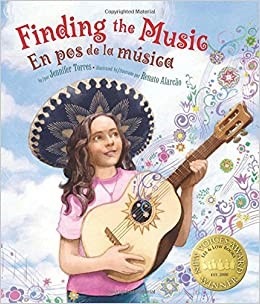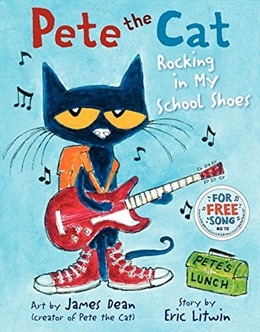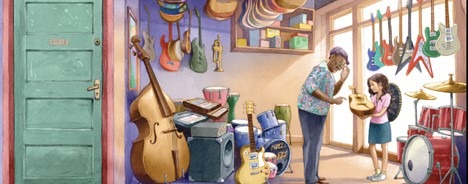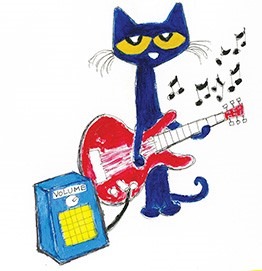NAfME BLOG
Yay Storytime! Musical Adventures with Children’s Picture Books, Part Twelve

/ News Posts / Yay Storytime! Musical Adventures with Children’s Picture Books, Part Twelve
Yay Storytime!
Musical Adventures with Children’s Picture Books, Part Twelve
By Thomas Amoriello Jr.
Immediate Past Chair of the NAfME Council for Guitar Education
The “Yay Storytime! Musical Adventures with Children’s Picture Books” series continues with article number twelve as we focus on works by authors Jennifer Torres and Eric Litwin. Finding the Music/En pós de la música and Pete the Cat: Rocking in My School Shoes provide viewers, readers, and listeners with songs, authentic and imaginatively colorful musical images, family heritage, music, reading and bilingual literacy, mariachi advocacy, and so much more.
Please feel free to leave comments on social media for open dialog or reach out to me directly at tamoriel@frsd.k12.nj.us to share which music-themed children’s picture books have been an asset in your classroom. On behalf NAfME, I would like to thank Ms. Torres and Mr. Litwin for sharing their knowledge with the membership.
Music is about memories, and I really like how your main character Reyna gets to know her abuelito and his music by way of a happy accident. Please tell NAfME members who was the inspiration for the story.
Jennifer Torres: Before I became an author, I worked as a local newspaper reporter. I covered a lot of school board meetings and a lot of fairs and festivals. But some of my favorite stories to write were obituaries. Perhaps that sounds unusual, but I loved learning about the extraordinary lives of ordinary people, and it was such an honor to be entrusted with a family’s memories. One obituary I wrote was about a farmworker who was also a mariachi musician. On weekends, when he wasn’t working, he gave free music lessons to children in the neighborhood. His wake was like a party, filled with laughter and songs performed by current and former students. One of his children said to me, “He wanted to rest in peace, but with music.” And that stayed with me. I wanted to write a story about someone whose music connected him to his community and connected his community to one another.
“Mariachi music has been in the background of so many life events in my family, from weddings, to birthdays, to funerals. I associate it with coming together and coming home.”
On a more personal level, mariachi music has been in the background of so many life events in my family, from weddings, to birthdays, to funerals. I associate it with coming together and coming home. I wanted to explore that idea of music as a collective memory.
In your book, children are introduced to the word mariachi which can open up dialogue related to the Mexican folk art. Besides your book, how would you introduce mariachi to an elementary, middle, and high school classroom?
JT: One of my favorite activities for students of all ages starts with showing how we bring our cultures, our histories, our hopes—our stories, really—to art, especially to music. I begin by playing a recording of Woody Guthrie singing “This Land is Your Land.” We talk a little about what was happening in the country when the song was written, and the feelings that Guthrie’s voice evokes. Then I play two different versions: one by Sharon Jones and, last, one by Las Cafeteras. We talk about how the words are the same in each song, but the stories are different. The meaning is different, based on the perspectives and backgrounds the artists bring. In my experience, students share some really incredible insights, and it’s a powerful way to begin discussing how mariachi is an expression of culture.
I also like sharing mariachi versions of more recent songs. It’s a way to help them identify what distinguishes the mariachi sound. More importantly, it emphasizes that mariachi is a living tradition.
Las Cafeteras: This Land Is Your Land

Make a Paper-Plate Vihuela (or Guitar)
I really love how Finding the Music is bilingual and is also important for children to see kids that look like them in illustrations. In addition, your children’s picture book could perhaps serve as an icebreaker with an ELL student getting to know about their family background and musical heritage.
JT: I think it’s essential for children and families to see their lives and experiences authentically reflected in children’s literature and across the curriculum, including music education. This tells students and parents that they belong, that their languages and their traditions have value and are valued.
“Literature, music and art have the power to build empathy, to make the world bigger, and to establish connections that students might not have otherwise been aware of.”
I think it’s just as important for students and families, particularly those who aren’t from marginalized communities, to see positive, authentic representations of cultures that are not their own. Literature, music and art have the power to build empathy, to make the world bigger, and to establish connections that students might not have otherwise been aware of.
Your story may also serve as a first visit to a music shop for young students, inspiring the future exploration of instruments including the vihuela and guitarron (mariachi ensemble guitar and bass).
JT: I hope so! On a couple of school visits, I’ve been able to share Finding the Music/En pós de la música alongside mariachi musicians, and it’s been really wonderful for students to be able to see and hear the instruments in person—especially to hear what the instruments sound like individually versus together. That’s sort of the magic of mariachi. If you happen to have a middle or high school mariachi program in your district, this can be a great option! If not, there are lots of videos out there of mariachi performance.
It is very clever how you named the restaurant in the story after a famous Mariachi song from the late 1800s. Have you heard from parents or educators about En pós de la música?
JT: With regard to “Cielito Lindo” in particular, I often hear, “That was my grandmother’s favorite song,” or “There’s a Cielito Lindo restaurant in my neighborhood too!” It means a lot to me that readers, especially parents and educators, are able to connect to the book on multiple levels.
Raymondville High School Mariachi (Raymondsville, Texas) performing “Cielito Lindo”

Finally on your website you posted a blog about “Celebrating Women in Mariachi.” Please share your thoughts with NAfME members.
JT: The main character in Finding the Music is named Reyna. I made that choice as a way of honoring mariachi trailblazers, such as Lola Beltran, who was known as “La Reina,” or the Queen, as well Mariachi Reyna de Los Angeles, an all-female ensemble based in Southern California, where I’m from.
Historically, men have had more visibility in mariachi, but women have made—and continue to make—important and influential contributions to the art.
Mariachi Reyna de Los Angeles is an all-women mariachi ensemble that has been leading the way for other female musicians in the historically male-dominated genre since 1994.

Please tell us about your background as a musician and what led to authoring children’s picture books with your mission statement “Bringing Early Literacy and Music Together.”
Eric Litwin: As a classroom teacher I began to see the extraordinary symbiotic relationship between early reading and early music. I was trying to help my students build their “reading foundation,” and music was key. Both early music/songs and early reading share the development of sounds, words, rhythm, expression, rhyme, meaning, and so much more. And music naturally helps engage students in language/reading experiences, creating optimal learning outcomes. I could not find enough books that combined early reading and early music together, and so I began to write my own. The first story that came out of this would eventually, many years later, become Pete the Cat, I Love My White Shoes.
“Both early music/songs and early reading share the development of sounds, words, rhythm, expression, rhyme, meaning, and so much more.”
Pete never stops moving and grooving and singing his song . . . because it’s all good. Please tell NAfME members about how you incorporate music and song into your virtual concerts and keynotes.
EL: After leaving the classroom I became an educational storyteller and musician in the Atlanta Metro Area. I visited hundreds of schools/libraries/festivals every year. This is where I developed my stories and interactive style. The key is to include music, call and response, repetition, and simple creative movement into every song and story. After I became a bestselling author, I continued to give hundreds of interactive concerts at schools/libraries/festivals across the country and world. Now during COVID-19 and social distancing I give interactive virtual concerts and keynotes. The very same interactive techniques work virtually with just a little adaptation. In fact, they are needed even more during virtual concerts to keep the audience engaged.
Pete the Cat is rocking in his school shoes discovering the music room, the lunchroom, the playground, and lots of other cool places at school. Please share with music educators about the resources available on your website as well as any additional information about Learning Groove.
EL: I have many wonderful resources to share with you to help make your music/reading time more interactive. On my website enjoy free downloads of my books and the dances that go with them. On Learning Groove we have an incredible free interactive song resource with lyrics, guitar chords, activity suggestions, and more.
The images of Pete the Cat as well as your other Groovy Joe books can really inspire a child to want to try out the six-string.
EL: Wonderful. I hope they do. Find sheet music to Pete the Cat, I Love My White Shoes here.
Tell about your professional development book that just came out called The Power of Joyful Reading, Help Your Young Readers Soar to Success! This is a very different type of book for you.
EL: All my picture books were intended to model how music, joy, and engagement help children learn to read. The last few years I have been focused on how these ideas can be put to work in the classroom to help all our children joyfully learn to read. The Power of Joyful Reading, Help Your Young Readers Soar to Success! explains how to immerse early childhood students in joyful and engaging reading throughout the day, every day, all year long. Learn more here.
“I know music and engagement and joy help children learn to read. So I do everything I can to move these ideas forward.”
Any advice to aspiring music educators wishing to author and create their own children’s book characters and stories?
EL: My advice to aspiring music educators who want to be authors and create their own children’s book characters and stories is to never give up and to stay positive. Pete the Cat, I Love My White Shoes, and Pete the Cat and His Four Groovy Buttons were initially rejected. And I have had countless other stories and ideas rejected. It is just part of the process. But I never stop trying. You have to fully believe in yourself and what you are doing. For me, I know music and engagement and joy help children learn to read. So I do everything I can to move these ideas forward.
Read past articles by Thomas Amoriello Jr.:
- Yay Storytime! Musical Adventures with Children’s Picture Books, Part Eleven
- Yay Storytime! Musical Adventures with Children’s Picture Books, Part Ten
- Yay Storytime! Musical Adventures with Children’s Picture Books, Part Nine
- Yay Storytime! Musical Adventures with Children’s Picture Books, Part Eight
- Kidz Are Gonna Rock
- Yay Storytime! Musical Adventures with Children’s Picture Books, Part Seven
- Guitar Class in 50 States: Coda
- Yay Storytime! Musical Adventures with Children’s Picture Books, Part Six
- From Sting to Sky: Interview with Ex-Scorpions Guitarist Uli Jon Roth
- Yay Storytime! Musical Adventures with Children’s Picture Books, Part Five
- A Grownup Conversation with Raffi
- Yay Storytime! Musical Adventures with Children’s Picture Books, Part Four
- A Conductor’s Tale: Interview with American Young Voices Conductor Francisco J. Núñez
- Yay Storytime! Musical Adventures with Children’s Picture Books, Part Three
- A Cultural Treasure: Interview with Sharon Isbin, Julliard Classical Guitar Program Founder
- The Season’s Greeting’s Guitarist: Trans-Siberian Orchestra’s Al Pitrelli
- Yay Storytime! Musical Adventures with Children’s Picture Books, Part Two
- The Student Teacher in the Guitar Classroom
- Double Trouble: Interview with Innovative Musician Gabriel Guardian
- The Patriotic Guitarist: Master Sergeant Alan Prather of “The President’s Own”
- Interview with Progressive Funk-Rock Guitarist DeWayne “Blackbyrd” McKnight
- Heavy Metal Guitar: Neo-Classical Style
- Heavy Metal Guitar: From Times Square to Netflix and Beyond
- Make a Sound! Interview with Drummer Michael Bland
- What about the Electric Bass?
- An Article for Jazz Educators: Interview with Guitarist Kevin Eubanks
- Hip Hop Empowers: Interview with Harlem-Raised, Boston-Based Hip Hop Artist Billy Dean Thomas
- Heavy Metal Guitar Style: Virtuoso Shred Guitar with Toby Knapp
- Adult Education: Rock Camp
- Musical Adventures with Children’s Picture Books
- Empowering the Musician in Your Classroom
About the author:
 Thomas Amoriello Jr. is the Immediate Past Chair of the NAfME Council for Guitar Education and is also the former Chairperson for the New Jersey Music Education Association (NJMEA). He has had more than fifty guitar and ukulele advocacy articles published in music education journals in Michigan, Ohio, Virginia, Washington, Illinois, Rhode Island, and New Jersey. Tom has taught guitar classes for the Flemington Raritan School District in Flemington, New Jersey, since 2005 and also teaches at Hunterdon Academy of the Arts. He has earned a Master of Music Degree in Classical Guitar Performance from Shenandoah Conservatory and a Bachelor of Arts in Music from Rowan University. During his time on the NJMEA board he directed guitar festivals and drafted the proposal to approve the first ever NJMEA Honors Guitar Ensemble.
Thomas Amoriello Jr. is the Immediate Past Chair of the NAfME Council for Guitar Education and is also the former Chairperson for the New Jersey Music Education Association (NJMEA). He has had more than fifty guitar and ukulele advocacy articles published in music education journals in Michigan, Ohio, Virginia, Washington, Illinois, Rhode Island, and New Jersey. Tom has taught guitar classes for the Flemington Raritan School District in Flemington, New Jersey, since 2005 and also teaches at Hunterdon Academy of the Arts. He has earned a Master of Music Degree in Classical Guitar Performance from Shenandoah Conservatory and a Bachelor of Arts in Music from Rowan University. During his time on the NJMEA board he directed guitar festivals and drafted the proposal to approve the first ever NJMEA Honors Guitar Ensemble.
Tom is an advocate for class guitar programs in public schools and has been a clinician presenting his “Guitar for the K–12 Music Educator” for the Guitar Foundation of America Festivals in Charleston, South Carolina, and Columbus, Georgia; Lehigh Valley Guitar Festival in Bethlehem, Pennsylvania; Philadelphia Classical Guitar Society Festival, Philadelphia, Pennsylvania; NAfME Biennial Conferences in Baltimore and Atlantic City; as well as other state music education conferences in New Jersey, Massachusetts, New York, and Virginia. He has twice been featured on episodes of “Classroom Closeup-NJ,” which aired on New Jersey Public Television. He is the author of the children’s picture books A Journey to Guitarland with Maestro Armadillo and Ukulele Sam Strums in the Sand, both available from Black Rose Writing. He recently has made a heavy metal LP recording with a stellar roster of musicians, including former members of Black Sabbath, Whitesnake, Ozzy Osbourne, Yngwie J. Malmsteen’s Rising Force, and Dio that was released on H42 Records of Hamburg, Germany. The record was released on 12-inch vinyl and digital platforms has received favorable reviews in many European rock magazines and appeared on the 2018 Top 15 Metal Albums list by Los Angeles KNAC Radio (Contributor Dr. Metal). The follow-up recording “Dear Dark” was recently released by Ice Fall Records on cassette (EP) and features former members of Megadeth, King Diamond, TNT and Dokken. He is also a music journalist for Boston Rock Radio and interviews many popular rock musicians. Visit thomasamoriello.com for more information.
Did this blog spur new ideas for your music program? Share them on Amplify! Interested in reprinting this article? Please review the reprint guidelines.
The National Association for Music Education (NAfME) provides a number of forums for the sharing of information and opinion, including blogs and postings on our website, articles and columns in our magazines and journals, and postings to our Amplify member portal. Unless specifically noted, the views expressed in these media do not necessarily represent the policy or views of the Association, its officers, or its employees.
December 29, 2020. © National Association for Music Education (NAfME.org)
Published Date
December 29, 2020
Category
- Uncategorized
Copyright
December 29, 2020. © National Association for Music Education (NAfME.org)










